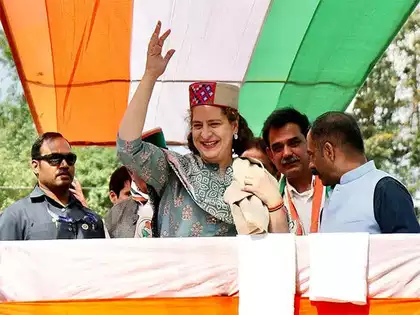Extensive Campaign Schedule
Priyanka Gandhi Vadra is undertaking a vigorous campaign trail for the 2024 Lok Sabha elections, which includes 108 public meetings and numerous roadshows across various constituencies. This extensive schedule highlights her commitment to engaging directly with voters and addressing their concerns personally. Additionally, she has participated in over 100 media interactions, ensuring widespread dissemination of the Congress party’s messages and policies.
She finished her Lok Sabha election campaign with a huge road show in Himachal Pradesh’s Solan. Then offering prayers to Hanuman at Jakhu temple, she held her last road show of this poll campaign at Solan, in which thousands contributed.
In her 55-day strong election campaign, Gandhi also addressed two meetings of thousands of Amethi and Rae Bareli workers. Polishing the Congress’ election campaign, Gandhi held two to three public meetings and road shows every day.
The strong campaign was conducted in Rae Bareli and Amethi, where she participated in an average of 8-10 conferences, welcome ceremonies, or road shows daily.
Priyanka Gandhi covered seats of tribal majority areas in Jharkhand, Marwar in Rajasthan, Eastern Rajasthan, Jaipur, Matsya region (Alwar) of Rajasthan, Durg division, Bastar division, Raigarh division of Chhattisgarh, and Chambal seats of Madhya Pradesh. The crowd that came to Ghandhi’s public meetings or road shows in Saharanpur, Dhubri, Fatehpur Sikri, Sirsa, Nandurbar, Kullu, Wayanad, Zahirabad, and Varanasi broke all records, the party said.
Focused Regional Outreach
Campaign Activities in Karnataka: In Karnataka, Priyanka has been actively campaigning to address local issues such as the need for a caste census and enhanced reservation policies for marginalized communities. Her visits and public meetings in cities like Bengaluru and Chitradurga aim to rally support by promising policies that reflect the demographic realities of SCs, STs, and OBCs.
Targeting Key Constituencies in Uttar Pradesh: Priyanka also focuses heavily on Amethi and Raebareli, traditional Congress bastions. Her strategy here includes meticulous booth-level management and extensive door-to-door campaigns, supported by senior leaders like Bhupesh Baghel and Ashok Gehlot, to ensure strong voter turnout and engagement.
Key Issues and Promises
Priyanka’s campaign heavily advocates for a comprehensive caste census and increases the reservation limits for SCs, STs, and OBCs. These promises aim to address systemic inequalities and ensure fair representation in policymaking. Her speeches often highlight the need for a special budget for marginalized communities, reflecting a commitment to social justice and economic empowerment.
Strategic Alliances and Support
Collaboration with Senior Congress Leaders: Priyanka’s campaign in key regions like Uttar Pradesh is bolstered by the support of prominent Congress figures such as Bhupesh Baghel and Ashok Gehlot. These alliances are crucial in amplifying her campaign’s reach and effectiveness, ensuring a well-coordinated effort across different levels of the party.
Booth-Level Management and Social Media Strategy: The Congress party focuses on robust booth-level management to ensure effective voter mobilization. This includes empowering local workers and leveraging social media to maintain a strong digital presence, disseminating campaign messages, and engaging with a broader audience.
Challenges and Opposition
Countering BJP’s Campaign Machinery: Priyanka’s campaign faces the challenge of countering the extensive and well-oiled campaign machinery of the BJP. Prime Minister Narendra Modi and other senior BJP leaders have maintained many public engagements, requiring the Congress to strategize meticulously to compete effectively.
Addressing Criticisms and Public Debates: Throughout her campaign, Priyanka has addressed various criticisms from political opponents, particularly the BJP. Her speeches and public appearances often involve direct responses to these criticisms, positioning the Congress party as a viable alternative to the current government.
Personal Engagement and Public Resonance
Connecting with Grassroots Voters: Priyanka’s campaign strategy includes personal engagement with grassroots voters, aiming to build a strong connection with the electorate. This involves traditional campaigning methods such as door-to-door visits and evening meetings with block-level teams to assess campaign progress and address local issues.
Leveraging Digital Platforms for Outreach: In addition to traditional campaigning, Priyanka is leveraging digital platforms to enhance her outreach. This includes using social media to communicate with voters, share campaign updates, and address a wider audience, ensuring that the Congress party’s message reaches every corner of the constituencies she is targeting.
These subheadings provide a structured overview of Priyanka Gandhi’s comprehensive campaign efforts for the 2024 Lok Sabha elections, highlighting her strategies, key issues, and challenges in this critical electoral battle.
Conclusion
Priyanka Gandhi Vadra’s extensive and dynamic campaign for the 2024 Lok Sabha elections signifies a robust attempt by the Congress party to reclaim its political stronghold and counter the BJP’s dominance. With 108 public meetings, numerous roadshows, and over 100 media interactions, her campaign is marked by a high degree of public engagement and strategic outreach. By focusing on key issues like caste census, and reservation policies, and addressing local concerns, Priyanka aims to connect deeply with voters, particularly in critical regions like Uttar Pradesh and Karnataka.
Her campaign strategy also includes leveraging digital platforms, enhancing booth-level management, and collaborating with senior Congress leaders to ensure a well-coordinated and effective electoral effort. Despite the challenges posed by the BJP’s extensive campaign machinery, Priyanka’s approach emphasizes personal engagement, grassroots mobilization, and a strong digital presence, which are essential for revitalizing the Congress party’s image and electoral prospects.
As the campaign progresses, Priyanka’s ability to resonate with voters, address their concerns, and present a cohesive vision for India’s future will be crucial in determining the success of her efforts and the overall performance of the Congress party in the upcoming elections. Her leadership and strategic planning reflect a commitment to not only challenging the current government but also reinvigorating the Congress party’s legacy and its role in Indian politics.
